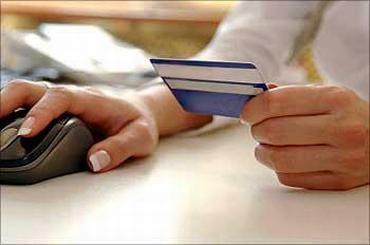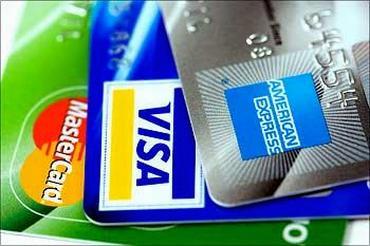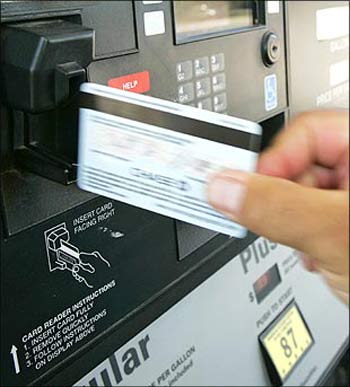Photographs: Rediff Archives
Easy to create and convenient to use, virtual credit cards also offer superior safety against frauds and misuse in online transactions.
While the advent of information technology has made life easier and convenient making everything just a click away, but it has also increased the susceptibility towards frauds as well. In that case, virtual credit cards can be very useful for all the credit and debit card holders.
What is a virtual credit card?
A virtual credit card (VCC) is a unique online payment solution with complete online security while shopping online. It is like an add-on card issued on the user's primary credit card.
VCC is one-time usable credit card which comes with a preloaded amount and they are valid only for a specified time period as required by the user. Virtual credit cards do not have a physical existence and they are created to be used online. Also the virtual card does not have any fee associated with it and comes for FREE!
The key details of the virtual credit cards like the card number, expiry date, CVV number etc. are used when transacting online, but user's primary card details are never shared with the merchant online, so the users need not worry about losing their card or having to carry it safely in their wallet.
Courtesy:
A dummy's guide to creating virtual credit cards
Photographs: Rediff Archives
How to create a virtual credit card?
Most banks or credit card issuers allow their customers to create virtual credit cards online.
You have to login into your bank's portal, go to the electronic/virtual/e-card section, fill in the details pertaining to your physical credit card – like card number, CVV details, amount for which you want a VCC, time period when it will lapse etc – and you will be good to use the VCC.
There are many banks which offer virtual cards instantly these days. Some of the banks are:
- ICICI VCC
- HDFC NetSafe
- Kotak netc@rd
- SBI-Virtual Card
- Axis Bank e-wallet card
A dummy's guide to creating virtual credit cards
Photographs: Rediff Archives
What is the validity of the virtual credit card?
The virtual credit card is valid only for a single use and automatically expires within 24 hours if the VCC is not used, which makes the credit card fraud or misuses minimal than a real a credit card. Also, one has to understand that if they hold a VISA card, then the virtual card which one will get will be VISA one and if it's Master Card, then the VCC will be a maestro one.
Most of the banks issue a card which is valid internationally and users can use them on the websites outside India, however some banks like State Bank of India still issue virtual credit cards which are only valid in India. Users will have to check with their bank if it is valid internationally or not.
A dummy's guide to creating virtual credit cards
Photographs: Rediff Archives
Can users create virtual credit cards using a debit card?
The answer is 'Yes' for most of the banks. Even if one just has a debit card and not a real credit card, they can still use their debit card to create a virtual card.
In the Internet era, people want to transact online all the time, but at times they do not hold a credit card. But now it has been easier for them as they can now they can create a VCC and use that to transact online.
A dummy's guide to creating virtual credit cards
Photographs: Rediff Archives
What if there is a refund from the merchant site?
In some situation it might happen that VCC users get a refund of the amount paid through VCC to the merchant site. This may be because of some defect in the product or due to poor service or any other situation. Since the payment is made through VCC (which has already lapsed being a one-time usable card), users can get the refund. The refund is automatically credited to the user's main card.
In the case where the VCC is partially utilised, the balance amount gets credited to the main card within a certain period of time in accordance with the banks' policy. For example, if a VCC is generated for Rs 1,000 and during the one time use the transaction value was only Rs 800, then in this case the remaining Rs 200 will be credited back to the user's main card and the VCC will lapse.
Conclusion
The VCC technology has been around for several years in abroad, but here in India it is fairly new. Now by using the VCC, credit card holders can be completely assured that their credit card details are not falling in wrong hands.






Comment
article